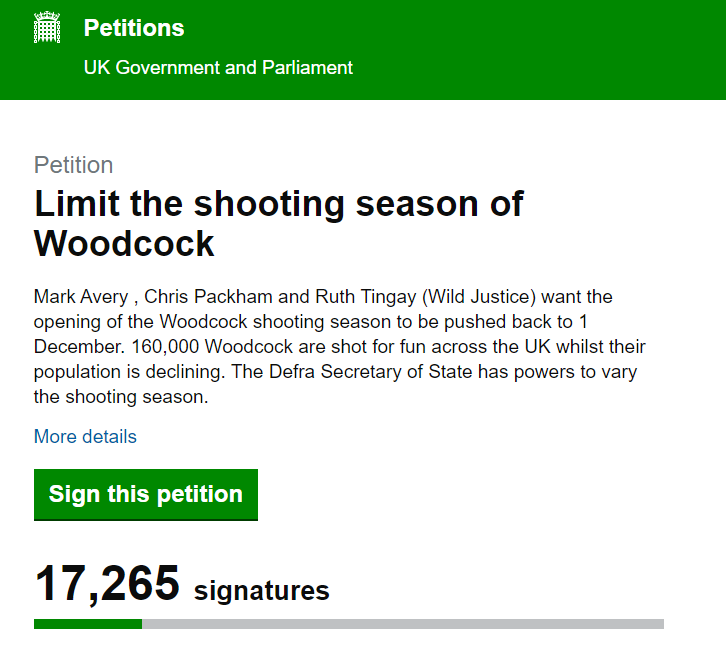Defra’s vague and evasive response to our Woodcock petition

Our petition seeking an important change to the Woodcock shooting season has received a response from DEFRA – it’s a poor response which is pasted below in seven numbered paragraphs but it amounts to 25 words highlighted in red.
We’re not satisfied with this as a response and Chris Packham has written to the Petitions Committee asking them to exercise their power to seek a proper response from DEFRA.
We’ll also now be seeking further signatures to the petition to increase the pressure and we ask you for your help in promoting the petition widely to gain more signatures.
There is still time for DEFRA to act before the shooting season opens, prematurely, on 1 October. We still want that date pushed back to 1 December as has been recommended by the Game and Wildlife Conservation Trust of all people.
Here’s what Chris Packham wrote to the Petitions Committee:
Dear Petitions Committee
I am writing in response to Defra’s response to the Wild Justice petition to limit the shooting season of Woodcock (Petition 619615).
The DEFRA response is not a proper response to our petition – most of it is just faff and padding. It is the type of response that will turn the public off engaging in the petitions process because it treats their request with disdain and entirely avoids addressing its key issue. Actually it’s insulting. So could I respectfully ask the Petitions Committee to solicit a proper response from DEFRA and ask for it to be provided as a matter of urgency because as it stands there is still time for DEFRA to adjust this year’s shooting season for this seriously threatened bird.
DEFRA’s response amounts to the 25 words highlighted in red below. It says that it doesn’t think that shooting is relevant but gives absolutely no science or evidence to back up this view. Nothing. This is unsatisfactory . . . it implies that Government could write down any old unjustified stuff to brush off petitions that are hugely supported by the public . . . and this would render the whole petition process pointless. It’s lazy, counterproductive, undemocratic and betrays a lack of accountability. But DEFRA are accountable to the public, the public who signed this petition. They need to get out of bed, summon some respect and prepare a proper reply.
In fact, as DEFRA must well know, and as spelled out in the link provided in our petition, the Game and Wildlife Conservation Trust recommend (on the basis of their own research) just what we suggest – that shooting of Woodcock should not start until 1 December rather than the current 1 October. Our petition asks that this is made a legal condition of shooting by changing the opening of the shooting season. This has not been in any way addressed by their response . . . Instead their response blathers on about grants, plans and schemes which are not yet running, may never run, and have not been practically tested in any regard for positive conservation outcomes and certainly not for Woodcock. Whereas what our petitioners request could be actioned now, for nothing, and the science says it would help.
Thus our petition is specific and scientifically well-informed whereas DEFRA’s response is vague and evasive – we ask for a specific well-justified government action, DEFRA waffles on about lots of other things it is doing or might possibly do. Thus this response is not adequate, like I said , it’s insulting and inadequate.
If this is how DEFRA responds to well justified conservation measures that can so easily, very cheaply and certainly quickly be implemented then we stand absolutely no chance of meeting the legally binding target of stopping wildlife decline by 2030.
I append the Defra response with further comments on its shortcomings below.
Best wishes
Chris Packham
In brief, paragraph by paragraph of DEFRA’s response: para 1, true but not a response to the petition and not specific to it, and promising nothing concrete; para 2, true but forms the background to our petition and is not a response to it; para 3, true, and is relevant to our petition but is not a response to it; para 4, DEFRA claims that many factors may be at play, they might be, but we have pointed to one simple government action that would address one factor and DEFRA has not ruled it out with any evidence, in fact it ignores the evidence that has led GWCT and ourselves to want shooting not to start until 1 December, therefore this is an inadequate response; paras 5-7, these all relate to aspirations to create or restore priority habitat in general (not necessarily habitat for Woodcock in particular) and planting trees won’t create habitat for woodcock until those trees are woodlands. This is an inadequate response and is not specific to our petition. They amount to saying ‘We’re doing some general stuff, or at least we might do in future, so we can’t do this very easy and simple thing that will help this species now’.
The DEFRA response:
- Defra published a Nature Recovery Green Paper considering options for reforming protection to better support the recovery of species, such as woodcock.
- All wild birds are protected in accordance with the provisions set out in the Wildlife and Countryside Act 1981. Some species of birds, including the woodcock, are listed in Schedule 2 of the Act, and may be hunted during the open season. In England and Wales, the open season for woodcock is from 1 October to 31 January. Outside of this period, the close season helps to make sure that woodcocks are able to breed successfully and move between breeding and wintering grounds.
- The first breeding woodcock survey was undertaken in 2003 and estimated a breeding population of 78,000 pairs in Britain. A further survey in 2013 estimated 55,000 pairs, representing a decline of 29%. As a result, the woodcock has been on the red list of Birds of Conservation Concern in the UK since 2015. During winter, our resident birds are joined by migrants from breeding populations in northern Europe and western Russia, increasing the Great Britain non-breeding population to 1.4 million individuals.
- The reasons for the decline of the breeding population of woodcock in Great Britain are not fully understood but are likely to include: disturbance; habitat loss as a result of land drainage; the drying out of natural woodlands; changes in surrounding woodland management; the maturation of new plantations; and overgrazing (reduction of the field layer) by deer. While further work is needed to enhance our understanding, the Government’s current view is that the woodcock population is more likely to be influenced by the extent and quality of habitat, rather than shooting. We will continue to keep this evidence under review.
- Woodcock will be supported by a number of measures already in train. We are committed to the recovery of species in England, and that is why within the Environment Act 2021 we have set a new legally binding target to halt the decline in species abundance by 2030. Since 2010, 364,803 football pitches of new priority habitat has been created or restored and we will continue to build on this as we develop the Nature Recovery Network. Furthermore, Defra published a Nature Recovery Green Paper consultation on proposals to support our ambitions to restore nature and halt the decline in species abundance by 2030. The consultation has now closed. We are considering the responses to the consultation and the Government will publish its response in due course.
- The woodcock will benefit from a number of woodland grant schemes funded by both the Countryside Stewardship scheme and the Nature for Climate Fund, some of which specifically target management for declining woodland birds. These grants include the Woods into Management Forestry Innovation Funds, which aim to restore vulnerable woodland habitats, improve biodiversity and conserve threatened species, as well as the England Woodland Creation Offer.
- More broadly, environmentally sustainable farming is fundamental to our agricultural transition outside of the EU. We are introducing three environmental land management schemes: the Sustainable Farming Incentive, Local Nature Recovery, and Landscape Recovery. These schemes will pay for activities to create, manage and restore habitats such as woodland, connecting isolated habitats to form networks, and species management, all of which will benefit woodland bird species, such as the woodcock.
